

Background: Digital assistants like Alexa and Siri
have evolved into a regular feature of our life these
days. Though the name usually conjures ideas of
science fiction, artificial intelligence has a very
major future in dentistry. The great growth in patient
information and recorded data calls for the use of
intelligence software and data computation.
Aim and Objective: The aim of this investigation was
to assess the perceptions, knowledge, and attitudes
of dental professionals in the Nagpur region with
respect to the application of artificial intelligence (AI).
Study Design: A descriptive cross-sectional study was
conducted to assess the role of Artificial Intelligence
among dental practitioners Practitioning in Nagpur
Region. A pre-designed, pre-validated questionnaire
consisting of 14 questions was distributed to 200
dental practitioners. The survey was administered
both personally, using printed questionnaires, and
via email. A total of 190 responses were collected. The
data was entered into a Microsoft Excel spreadsheet for analysis, and descriptive statistical analysis was
performed using IBM SPSS version 26. The use of
descriptive statistics was utilized in to estimate the
percentages of the responses from the participants.
A Chi-Square test (X2) was performed to examine the
data, where the significant level was set at P < 0.05.
Results: Majority of the participants, specifically
93.9%, believed that artificial intelligence (AI) will
pose a threat to dentists in the future. On the other
applications of AI.
hand, 42.4% of practitioners were aware of the applications of AI.
Conclusions: The study found that most participants
were aware of AI and its applications. The survey
solely included Nagpur dentists. Other parts of India
or countries with varied technological adoption rates
and AI awareness in dentistry may have different
results.
Key words: machine learning (ML); artificial intelligence (AI); voice command dental chairs; virtual dental assistants
The human brain, considered the pinnacle of
evolution, is the most intriguing and intelligent
on Earth. Technology has been used to mimic
human intellect since the 1950s1. This quest led
to AI.
Artificial intelligence is a development in the
modern science and technology. Many call it
“The Stethoscope of the 21st Century.” This
description emphasizes the medicinal and
dental importance of this tool2.
Artificial intelligence (AI) mimics human
intelligence in computers that learn, understand,
and decide. Robotics, computer vision, natural
language processing, and machine learning
enable systems to perform cognitive tasks
including pattern identification, problem solving,
and decision making. AI can be divided into
two categories: General AI replicates human
intelligence in many activities, while narrow AI
is designed for specific tasks.
AI is used in healthcare systems, self-driving
cars, robotics, virtual assistants like Alexa
and Siri, and facial recognition technology.
Technologically advanced India is nearing its
full potential in this area. Despite its pervasive
influence,
many people, even medical
professionals and researchers, are unaware
about artificial intelligence (AI) and its potential
effects on personal and professional life.
Artificial intelligence algorithms are used in
dentistry; especially diagnostic radiography
benefits new dentists. AI analyzes face
development, tracks cephalometric landmarks,
detects cavities, alveolar bone loss, periapical
pathosis, and auto-segments the inferior alveolar
nerve3. Studies reveal that artificial intelligence
is increasingly used to detect cervical lymph
node metastases, mouth cancer, and orofacial
disorders and for treatment planning4. Future
AI-driven intelligence is projected to reduce
educator workload and education costs. Dental professionals must grasp AI technology and
adapt to new roles in clinical practice.
Therefore, this survey research was conducted
to evaluate the perception, knowledge and
attitude of artificial intelligence among dental
practitioners practicing in the Nagpur region.
This simple random sampling cross-sectional
descriptive study was conducted using a pre
validated and pre-designed closed-ended
questionnaire (Annexure-I). The questionnaire
was distributed to dental practitioners in the
Nagpur region through personal contact with
the printed questionnaire and via email. This
study has been approved by the Institutional
Ethics Committee. There were a total of two
hundred dental practitioners who responded
to questionnaire. The questionnaire consists of
fourteen questions.
Following the completion of the data collection
process, it was later imported into a spreadsheet
created in Microsoft Excel. A descriptive
statistical analysis was carried out by using
Statistical Package for Social Sciences (SPSS)
version 26, which was developed by SPSS Inc. in
Chicago, Illinois, United States of America. The
use of descriptive statistics was utilized in order
to estimate the frequencies and percentages
of the responses from the participants. A Chi
Square test (X2) was used to examine the data,
and the significance level was set at P < 0.05.
(I). Demographic Details
Fig. 1 represents the gender distribution
of the participants. A total of 56% of the
participants were male and 44% were females.
(II). Awareness on the role of AI in Dentistry
Fig. 2 shows 87.4% of dentists were aware of the
AI based applications that have already been used in the dentistry. The results obtained were
statistically significant [p= 0.022].
Fig. 3 depicts the awareness of the participants,
on Artificial Intelligence (AI) and Machine
Intelligence (ML) is the same or not. The majority
of participants (98.5%) were aware that AI and
ML are the same. The results that were obtained
were quite significant from a statistical point of
view [p = 0.000].
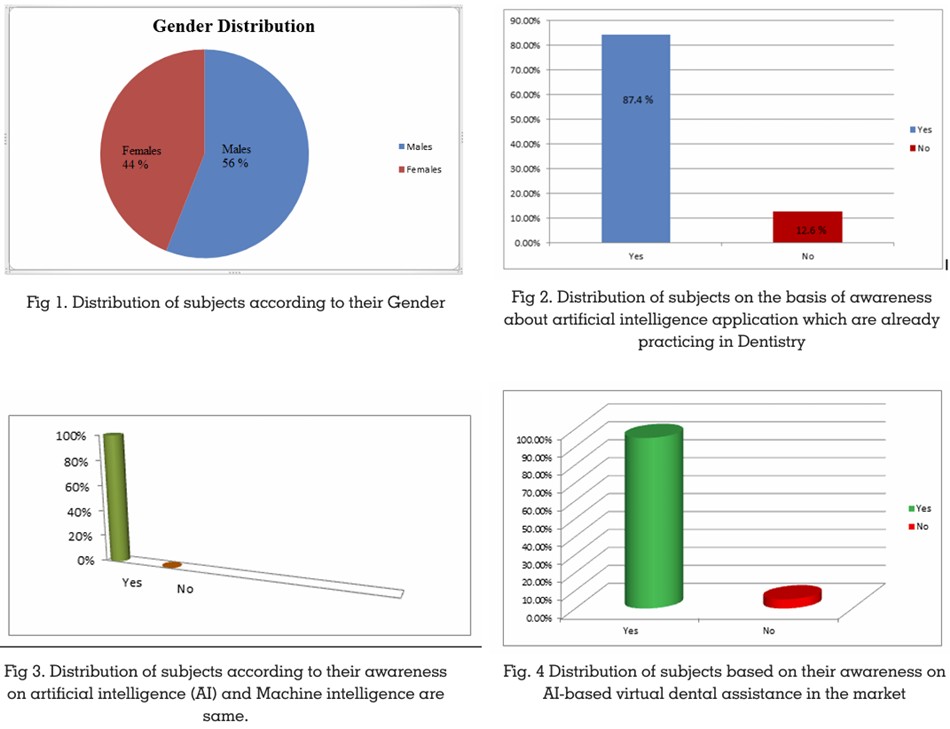
Fig. 4 shows 94.9% of the participants were aware
of the virtual dental assistants which are based
on artificial intelligence and are accessible on
the market. it. Whereas the least awareness seen among (6.1%) participants. The results that were
obtained were quite significant from a statistical
point of view [P = 0.000].
Figure 5 shows that the Virtual dental assistants
perform more accurately, although only 32.4%
of people were aware of them while 64.40
percent of participants are still not familiar
with AI-based voice-activated dental chairs.
[P=0.000] indicated that the results were
statistically significant.
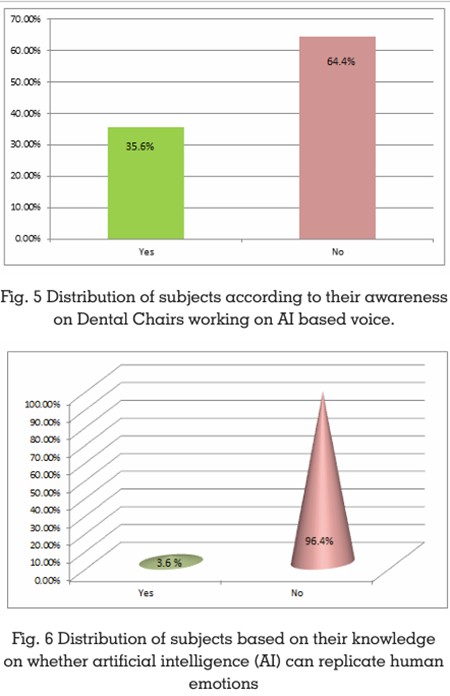
Fig. 6 shows that all the participants except 3.6%
firmly believed that AI cannot duplicate human
emotions. The results obtained were statistically significant [P = 0.008].
Fig.7 shows the information about the ‘Haptic gloves’ which can offer a particular tactile
experience. Nearly all (98.5%) are aware of the
special quality of Haptic gloves. The results
obtained were statistically significant [P =
0.001].
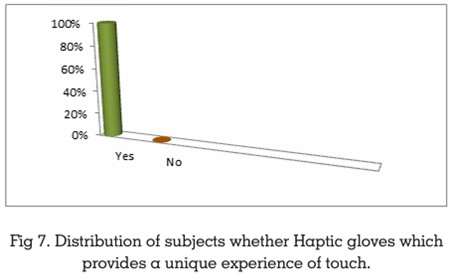
Fig.8 shows AI can accurately predict oral cancer
genetic propensity in a large population. Nearly
all participants (99.3%) said AI can reliably
forecast oral cancer genetics in a big population.
The results obtained were statistically significant
[P = 0.008].
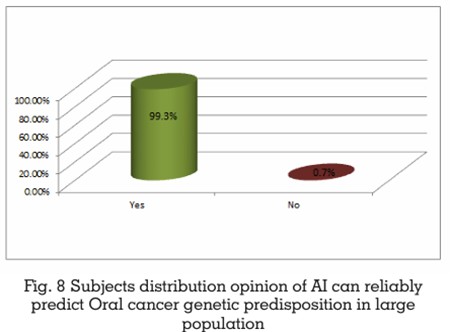
Fig.9 shows that AI can generate a complete
virtual database for each patient. Nearly
all participants (99.3%) said that Virtual
patient databases can be created by using
AI applications. The results obtained were
statistically significant [P = 0.022].
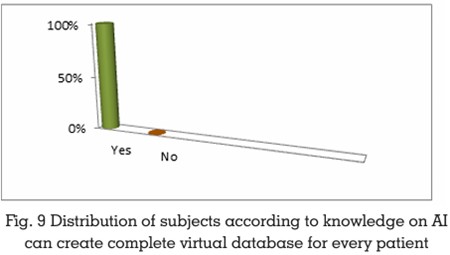
In total, 190 members participated. Out of which,
(97) are male and (93) are female. A significant
proportion of the participants, specifically 93.9%,
held the belief that artificial intelligence (AI) will
pose a threat to dentists in the future. On the
other hand, 42.4% of practitioners were aware of
the applications of AI that are now being utilized
in dentistry.
Artificial Intelligence (AI)
was initially
conceptualized as “machines thinking” by Turing
AM, who proposed the ‘Turing test’ to evaluate
whether machines could achieve human-level
intelligence. In the present study, a significant
percentage of participants (88.5%) were aware
that Artificial Intelligence (AI) and Machine
Learning (ML) are synonymous terms.6 As noted
by Banerjee M et al.5, Ma J et al.7, and Isra ST
et al.8, AI is regarded as an application that
complements rather than replaces the human
brain, providing additional information and
assisting clinicians with accuracy. The results of
the present study strongly indicate (99.3%) that
AI cannot replicate human emotions. Sefira F
suggests that AI can detect things imperceptible
to humans.9
AI serves as a valuable tool for patient
education, exemplified by products like Genius
X, a toothbrush from Oral-B, which can detect
brushing techniques and provide guidance to
users5. Some dental institutions have begun to
recognize the significance of AI in enhancing
the learning experience for dental students.
According to Topol EJ, AI implementation can
lead to reduced post-operative complications,
fewer unnecessary procedures, and overall
improved healthcare quality.10
The dental practice is already experiencing the
utilization of Virtual Dental Assistants, which
are readily available in the market. Studies by Khanna S et al.11 and Rieshy V et al.12 have
indicated that virtual assistants can perform
certain routine tasks more accurately than
physical dental assistants. In our present study,
47.4% of teaching faculty were aware of the
availability of Dental Virtual Assistants in the
market. Other studies, such as those by Lim K et
al.13 and Yeager D et al.14, have highlighted the
efficacy of AI applications in identifying malignant
and premalignant changes in oral mucosa, thus
facilitating improved treatment. Bas B et al. have
suggested that AI can differentiate between
low and high-risk malignant lesions and aid
in treatment planning.15 In contrast, Majumdar
B et al. have proposed that AI could accurately
predict genetic predispositions for oral cancer
within a large population.16 However, our study
results contradict these findings.
The applications of Artificial Intelligence (AI),
already showing its footprints in various dental
speciality treatments which includes Radiology
and diagnosis15,16, Pediatric Dentistry17;
Periodontics18,19; Implantology20,21; Maxillofacial
Surgery22; Orthodontics23-25; Prosthodontics2,26-29;
Endodontics30,31; and Forensic Odontology32. The
present study 67.6% participants of the opinion
that AI based applications are already using in
various dental specialities.
However, the adoption of AI in dentistry is
progressing slowly and is accompanied by
certain concerns among clinicians. According
to Tandon D Rajawat, the utilization of AI is
complex, expensive, and requires meticulous
training to handle the software, while concerns
regarding the potential compromise of patient
data further contribute to apprehension.33
Although the use of AI in the medical field
dates back several decades, its adoption in
dentistry began around four decades ago. AI
applications in dentistry initially emerged in
dental tutoring systems, marking its inception
into the field.34 Crowley R et al.35 demonstrated significant improvement in preclinical skills
among students through the utilization of
virtual patients. The introduction of AI in the
form of the Unified Medical Language System
(UMLS) represents a substantial advancement
in manual teaching methods. Feeney L et al.36
noted that the application of AI in dental student
training allows for individual self-assessment,
contributing to enhanced learning experiences
and attain improved professional skills.
“The creation of a comprehensive virtual
database for all patients using AI software
has been a practice adopted by many dentists
worldwide for a considerable period.37,38 The
findings of the present research align with
previous studies in this regard. Aminoshariae
A et al.39 assert that AI usage in dentistry is
cost-effective, reliable, efficient, thorough, and
expeditious. However, Shan T et al.40 note that
AI lacks human communication, a crucial aspect
in healthcare services, such as clinical intuition
and physical touch.
Nguyen TT et al.41 raise concerns about the
accountability of AI in dentistry. While AI usage
yields promising clinical results, questions arise
about liability for conflicting outcomes or errors
during treatment. The majority of teaching faculty
in the present study (93.9%) expressed concerns
that AI applications in dentistry may pose a
threat to dentists in the future. In contrast, a study
conducted in Saudi Arabia by Aboal shamat KT
42 found that a smaller percentage (49.1%) of
dental professionals agreed or strongly agreed
that AI could replace dentists in the future.
It is common to encounter myths surrounding
the use of new technologies initially, but as
positive results emerge, these myths tend to be
dispelled. Nonetheless, nearly all participants in
the present study (98.5%) expressed their belief
that AI-based treatments would be accepted by
patients.
Recent innovations in the dental field include
the Digital Dental assistant (DeXVoice),
which is currently available in the market.43,44
Additionally, dental chairs equipped with AI
incorporated voice command technology have
been introduced.2 To maintain human touch
sensations, ‘Haptic gloves’ are now commercially
available.45
The present study’s findings on Haptic gloves
indicate that nearly all participants (98.5%) are
aware of their tactile exclusionary property.46 AI
demonstrates the ability to distinguish between
healthy and non-healthy tissues in the oral cavity.
Furthermore, the Bio/Screen Oral Exam Light is
equipped with Artificial Intelligence software.47,48
The field of ‘bioprinting’ of both hard and soft
tissues is one of the most inventive applications
of artificial intelligence (AI).
The study was conducted exclusively among
dental practitioners in the Nagpur region. The
findings may differ to other regions in India or
to other countries with different technological
adoption rates and levels of AI awareness
in dentistry.
The majority of participants expressed their
opinions regarding AI-based treatments, and
all of them were aware of the most recent
advancements in AI in the field of dentistry.